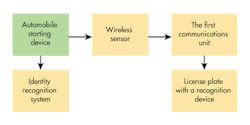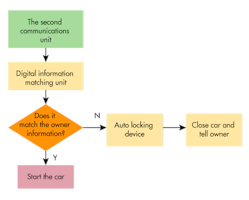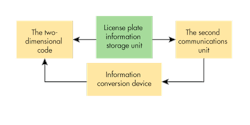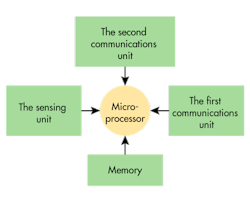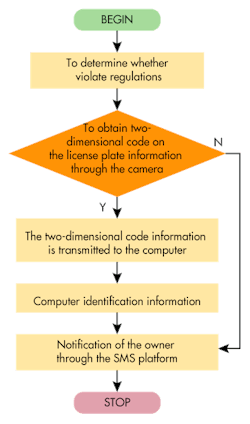This file type includes high resolution graphics and schematics when applicable.
Vehicle theft, it goes without saying, is never something pleasant to experience. Luckily, it is now possible to limit its frequency. The wireless sensor system described in this article (Fig. 1) is designed to prevent theft and “borrowing” of automobile license plates. It incorporates a variety of wireless sensors connected with the license plate via two communications devices.
The wireless sensor is connected to the license plate through the first device, while the automobile starting device comprises a second communication unit and digital information processing unit. The second communications unit is connected with the wireless sensor, and a digital information matching unit connects the wireless sensing system to an identification system.
The identification system may combine a fingerprint recognition system, a face recognition system, or both. The wireless sensors, the first communications unit, and second communications unit are connected by either wired or wireless means. Digital information processing is performed in a digital information matching unit, or digital information processor, or ARM processor (from ARM Holdings). The license plate with recognition device comprises a license plate information storage unit and information conversion device with a two-dimensional code module.
The license plate information storage unit and information transformation device are connected, respectively, with the two-dimensional code module and the first communications unit. The microprocessor is connected with the sensing unit and the memory, while the sensing unit is provided with a sensor and a digital-to-analog converter (DAC). Furthermore, the sensing unit, microprocessor, and wireless sensor memory are connected to the power supply unit.
For this system to operate effectively, it must be connected to a database containing the personal information of a vehicle owner, including the vehicle owner’s ID card, driver’s license number, license plate number, a two-dimensional code for the wireless sensing system, and his digitized fingerprint. If the vehicle is connected to such a database (Fig. 2), when someone opens the vehicle door and touches the fingerprint ID system, information will be relayed to the vehicle’s starting device.
If the fingerprint is acceptable—and the license plate matches the numbers stored in the digital information matching module through comparison with information in the device matching module—the unit will start the engine through the automobile starting device by means of code through the DAC. If the two pieces of information do not match, a self-locking device will lock the car.
In the matching of license plate information, details about the license plate are transferred to the receiver of the car starting device unit through wireless sensors and by means of the DAC matching unit. The identification system serves to verify the identity of the automobile owner. If the registered information matches the tested information gathered by the wireless sensor system, it will identify the owner. The wireless sensor system can also work with a facial-recognition device which would provide similar functionality as the fingerprint ID system.
The first communication unit, which is used to receive and transfer information from the various wireless sensors, in installed in a vehicle’s license plate area (Fig. 3). This unit is connected to the two-dimensional code module through the license plate information storage unit and then transmits effective information to the wireless sensor. When a camera detects a vehicle’s two-dimensional code and transmits it to the monitoring system, the owner’s vital information is clearly visible.
The system can also work by transferring the vehicle’s license plate number to the second communications unit, with the information transferred in two-dimensional code through the information transformation device. If a vehicle’s license plate has been changed, and the wireless sensor system has not been updated, the changed license plate will be detected by a road camera and its communications network. The wireless sensor system’s role is to improve the transmission and reception of important vehicular information to roadside communications networks (Fig. 4), hopefully helping to improve roadside safety.
This file type includes high resolution graphics and schematics when applicable.
2D License Plate
This file type includes high resolution graphics and schematics when applicable.
With the new wireless sensor system, a two-dimensional license plate containing information about the vehicle and its owner takes the place of the traditional license plate (Fig. 5). Roadside cameras are then used to photograph the new license plate. The camera also is programmed to detect if a scanned vehicle has violated local traffic regulations, and can communicate to a public security network and start the process of communicating with that network to determine if the driver has violated any traffic rules or laws.
This wireless sensor system is in its development stages, but it offers several advantages for drivers and vehicles. The system can be connected to a local government’s public security department, which can gather more data on the vehicle owner, including fingerprints, ID cards, and information about the vehicle. The fingerprint ID for starting a car is an effective method of reducing motor vehicle theft.
Another advantage of the wireless system is that it makes it difficult to switch or change license plates to use a car, in the process reducing the offense for replacement of vehicular license plates. Finally, the use of roadside cameras and a vehicle’s two-dimensional code can help to reduce illegal behavior on the road and, hopefully, make it a safer place for drivers and non-drivers alike.
An Junfeng, Postgraduate
College of Information Science and Technology, Donghua University, Shanghai 201620, People’s Republic of China; 188-18236670
Lumeng Meng, Postgraduate
College of Information Science and Technology, Donghua University, Shanghai 201620, People’s Republic of China; 188-18233249
Shandong Laiwu, Postgraduate
Shandong Zibo, Postgraduate
College of Information Science and Technology, Donghua University, Shanghai 201620, People’s Republic of China
References
1. Atmel Corp., San Jose, CA, 95110, ARM7TDMITM (Thumb) Datasheet, 1999-01; ARM7TDMI Revision: r4p1 technical reference manual, 2004.
2. Chen Long Tang, Zhiqiang Zhang, and Liang Tu, “Embedded technology and systems development of Intel XScale architecture,” Beijing University of Aeronautics and Astronautics Press, Beijing, China, 2004-2006.
3. Chunlei, “ARM architecture and programming,” Tsinghua University Press, Beijing, China, 2003.
4. Ma Zhongmei, “Intel-based and other ARM-based embedded processor architecture and applications,” Beijing University of Aeronautics and Astronautics Press, Beijing, China, 2002.
5. Standard 1149.1, “Test Access Port and Boundary-Scan Architect,” IEEE, New York, NY.
This file type includes high resolution graphics and schematics when applicable.


